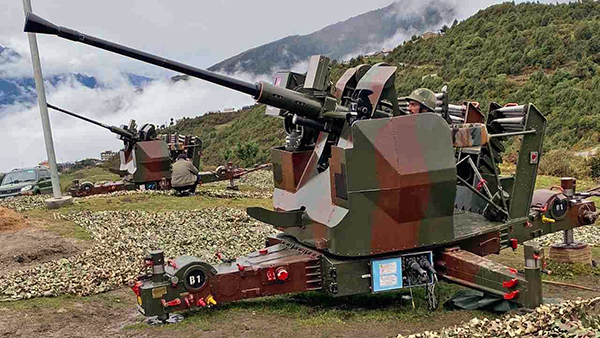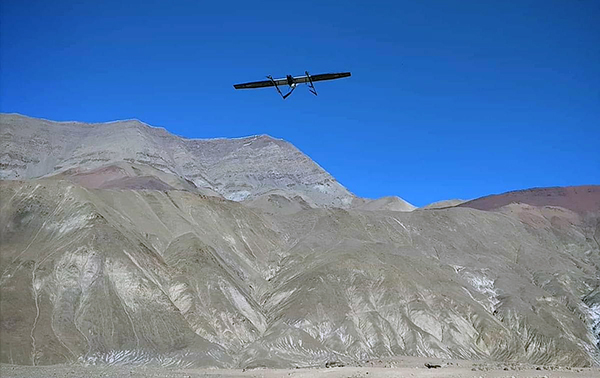AD Guns, ULH Heron Drones Deployed
The Army has significantly augmented its firepower along the 1300-km-long Line of Actual Control (LAC) in the Eastern sector, while also beefing up overall defences in the region, especially in the Tawang sector, by integrating various services in realtime through automation. This includes upgraded L-70 air defence guns, M777 Ultra Light Howitzers, and automated and electronic fusion of Bofors and other artillery guns deployed along the LAC.
Eastern Army Commander Lt Gen Manoj Pande, on 19 October, said that China has increased the intensity of military exercises and deployment of troops in its depth areas opposite the Arunachal Pradesh sector and that India has correspondingly readied contingency plans to deal with any eventualities.
Army has set up “integrated defended localities” at several locations along the LAC. These integrate various arms of the Army like infantry, engineers, artillery, air defence, aviation and also the fighter aircraft of the Air Force, to respond to any threat in realtime and bring in maximum firepower, explained Maj. Rufus Johnson, a Company Commander at one such locality near the LAC near Bumla.
Integrated defensive battle is not fought at the company or battalion level. It is a cohesive and coordinated battle fought employing all arms and services that are available with the armed forces. Army had infused significant technology to fuse various sensors and platforms for battlefield transparency and also quick response.
Upgraded L-70 air defence guns have been deployment in high altitude areas for the first time. The limitations associated with the upgraded guns have been overcome by incorporation of state of the art components, latest technology, making it a potent weapon system against all low level air threat that include unmanned aerial vehicle, unmanned combat vehicle, attack helicopter and modern aircraft, to increase the target acquisition and automatic tracking capabilities of the gun.
The gun is also equipped with a Muzzle Velocity Radar for enhancing the accuracy of fire. The gun has the ability to be integrated with tactical and fire control radars which give it more flexibility in its deployment. The upgraded gun system that operates along with a high-end Israeli radar can be counted among the best available air defence guns in its class globally.
The L-70 guns was manufactured by Swedish company Bofors AB in 1950s and India procured them the late 1960s. These legacy guns were upgraded by Bharat Electronics Limited (BEL).
Ultra Light Howitzers
The M-777 Ultra-Light Howitzers inducted in November 2018 has been deployed all along the LAC. The M777 is a 155-mm, 39-calibre towed artillery gun and weighs just four tonnes.
India has contracted 145 M777 guns from BAE Systems, of which over 75 had been delivered. Three regiments had been deployed and the fourth was in the process of being raised.
The M777 had given significant flexibility in employment options for long range fire power, one officer posted near the LAC said on condition of anonymity. It can be airlifted by Chinook heavy lift helicopters to any forward location at short notice in case of any contingency.
In addition, the Army had long deployed the legacy and battle-proven Bofors guns along the LAC. They had now been made more effective and the response time significantly improved under Project Shakti undertaken by BEL, by integrating them electronically with the command centre and forward troops.
Heron drones
Advanced Heron drones procured from Israel are operational now and are far more advanced than the Herons in the existing inventory and their anti-jamming capability is much better than their previous versions.
The acquisition of these drones has been done under the emergency financial powers granted by Prime Minister Narendra Modi-led government to the defence forces under which they can buy equipment and systems worth Rs 500 crores to upgrade their warfighting capabilities, amid ongoing border conflict with China.
Other small or mini drones are being acquired from Indian firms.
The Indian defence forces have been taking these initiatives to acquire weapon systems that can help them in the ongoing conflict with China. The last time such a facility was given to the defence forces was in 2019 right after the Balakot airstrikes against terrorist camps in Pakistan.
The Indian Air Force has also exercised emergency financial powers to acquire a large number of anti-tank guided missiles, long-range precision-guided artillery shells along with the Hammer air to ground standoff missiles with a strike range of around 70 kilometres.
Unmanned Ground Vehicles
The Army is on the lookout for Unmanned Ground Vehicles (UGV) to assist infantry troops in high-altitude areas with surveillance, tactical reconnaissance, targeting enemy positions, delivering critical supplies, and carrying out rapid evacuations. The need for such a platform stems from the difficulties encountered in Ladakh, such as incidents involving a military clash with China at heights of over 15,000 feet.
The army’s requirements for the platform state that the unmanned ground vehicles, or UGVs, should be able to carry a load of 250500 kg and should be able to operate in high altitude areas along the northern borders—a reference to the frontier with China.
A weapon platform variant mounted with a machine gun has also been listed as one of the requirements that the UGVs should have. Twelve Indian companies will showcase 35 such platforms to the Indian Army in Babina from December 9-14 in an experiment called “Strike”—surveillance, tactical recce, intelligence, kinetic effect, and evacuation systems.
Over 30 different types of unmanned ground vehicles were showcased by the developers, and these will be embedded with sub-units for tactical exploitation. The experiment involves various categories of UGVs, viz., surveillance, reconnaissance, intelligence, kinetic effect, logistics, casualty evacuation.
The unmanned vehicle that the army is looking for should perform recce and surveillance and have a load carrier aimed at last-mile delivery and casualty evacuation. The unmanned vehicles can also be used for explosive detection and neutralisation of improvised explosive devices. The army has stated that a robotic arm with the capacity to lift a minimum weight of 5 kg is a must.
According to the army’s requirements, the UGV should be able to operate in varied terrain conditions, including deserts, plains, mountainous and high-altitude areas, existing along our borders. The army wants the vehicles to be operated remotely as well as in an autonomous mode. The requirements further state that it should be able to place explosives and carry out remote detonations of identified IEDs and mines.




















